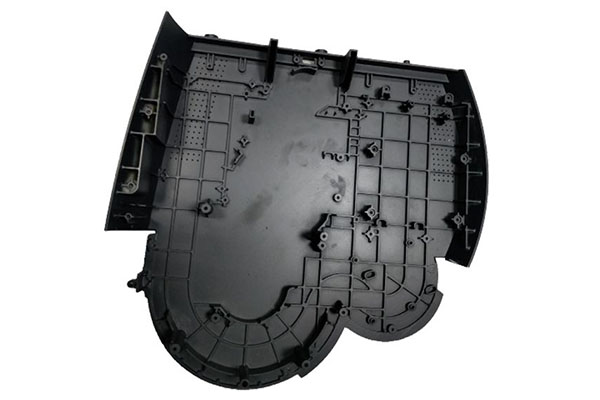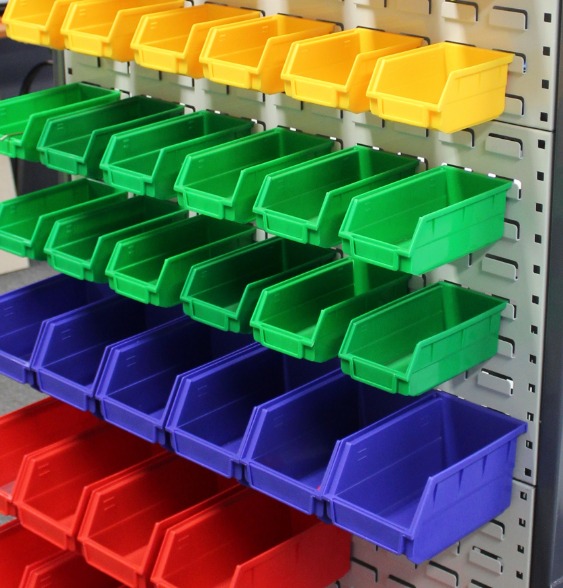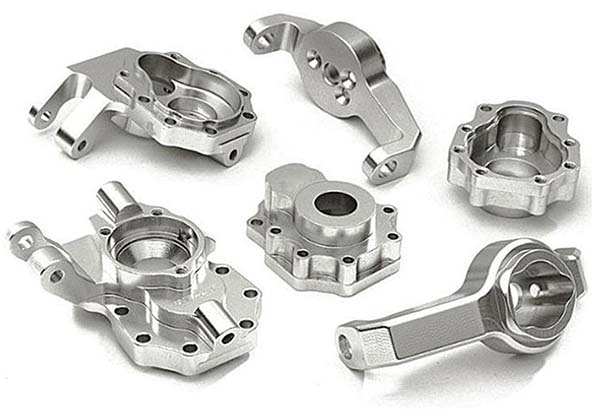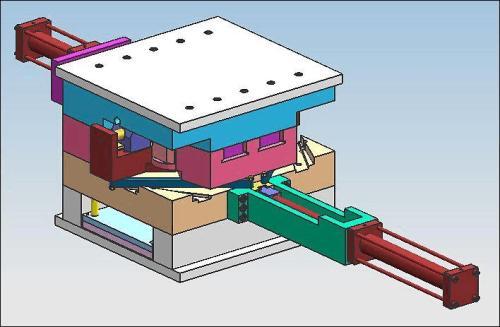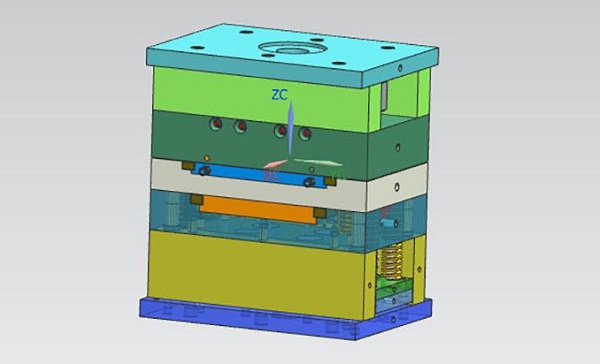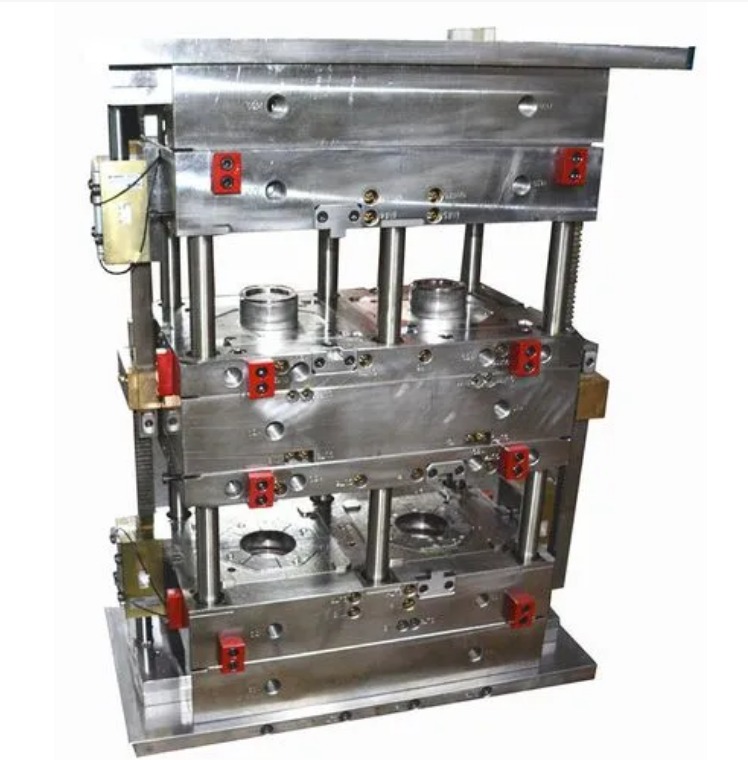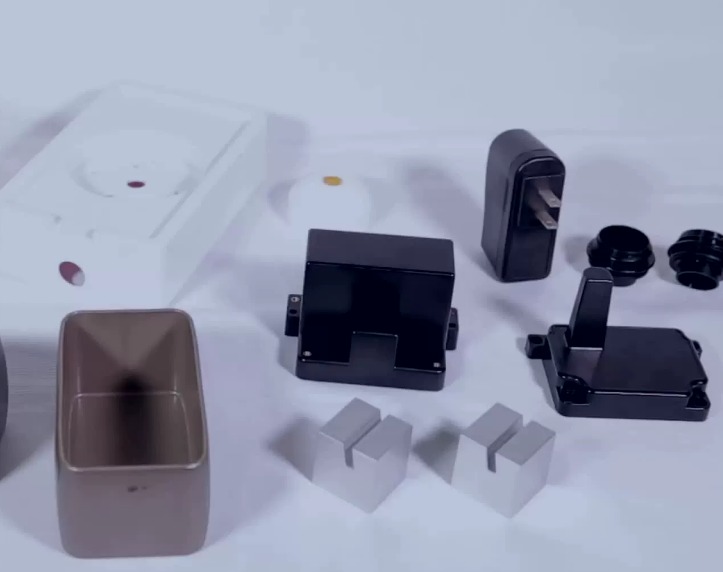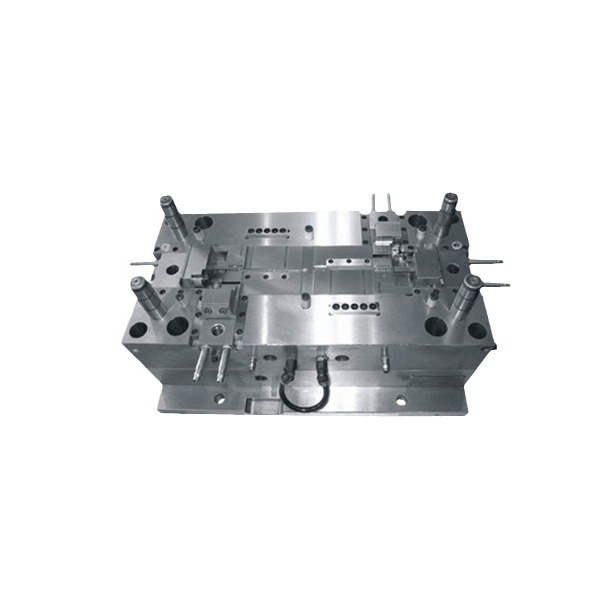Introduction
Definition and Process of Injection Molded Plastic
Injection molded plastic refers to the plastic products formed through the injection molding process. This widely - used manufacturing method begins with melting plastic pellets in a heated barrel. Common plastics used in this process include polyethylene (PE), polypropylene (PP), acrylonitrile butadiene styrene (ABS), and polycarbonate (PC). Once the plastic is fully melted and reaches a suitable viscosity, it is forced, usually by a reciprocating screw, under high pressure through a nozzle into a closed mold cavity.
The mold, typically made of steel or aluminum, has a cavity machined to the exact shape of the desired final product. After the molten plastic fills the cavity, it cools and solidifies. Once solid, the mold opens, and the finished plastic part is ejected, ready for further processing or immediate use. For example, the production of plastic toys often involves injection molding, where colorful plastic materials are transformed into various shapes like action figures or building blocks.
Mechanical Properties
Strength and Toughness
Tensile Strength
Tensile strength is a crucial mechanical property that measures the maximum stress a material can withstand while being pulled before it breaks. For injection - molded plastics, it varies significantly depending on the type of plastic and any additives or reinforcements used. For example, the tensile strength of unfilled polypropylene (PP) typically ranges from 21 - 39 MPa. However, when 30% long glass fiber (LGF) is added to PP, its tensile strength can reach up to 110 MPa. In comparison, acrylonitrile butadiene styrene (ABS) has a tensile strength in the range of 35 - 62 MPa.
In automotive manufacturing, injection - molded plastics with high tensile strength are widely used. For instance, PP - based materials with high tensile strength are often used to produce car bumpers. The high tensile strength ensures that the bumper can withstand certain impacts during normal driving and minor collisions without breaking easily, providing protection for the vehicle and its occupants.
Impact Resistance
Impact resistance refers to a plastic's ability to absorb energy and resist fracture when subjected to sudden impact loads. Different injection - molded plastics have different levels of impact resistance. High - impact polystyrene (HIPS) is known for its relatively good impact resistance, with an impact strength (notched Izod) of around 15 - 25 J/m. In contrast, polycarbonate (PC) has an extremely high impact resistance, with a notched Izod impact strength of approximately 650 - 900 J/m.
This property is vital in many applications. For example, in the production of safety helmets, materials with high impact resistance like PC are often chosen. When a helmet - wearer experiences an impact, the high - impact - resistant plastic of the helmet can absorb a large amount of the impact energy, reducing the force transmitted to the head and thus protecting the wearer from serious head injuries. In the electronics industry, the outer casings of devices such as laptops are often made of impact - resistant plastics. This helps protect the internal components from damage when the laptop is accidentally dropped or bumped.
Flexibility and Rigidity
Flexural Modulus
The flexural modulus, also known as the modulus of elasticity in bending, is a measure of a material's stiffness or resistance to bending. It indicates how much a material will deflect under a given bending load. Different injection - molded plastics have distinct flexural modulus values. For example, the flexural modulus of LDPE (low - density polyethylene) is relatively low, around 100 - 300 MPa, which makes it quite flexible. On the other hand, the flexural modulus of glass - fiber - reinforced nylon 66 can be as high as 6000 - 10000 MPa, making it very rigid.
In the manufacturing of plastic pipes, the flexural modulus plays a crucial role. Pipes made of materials with a high flexural modulus, such as some engineering plastics, can maintain their shape and integrity when buried underground or when subjected to external loads, like being stepped on or having soil pressure exerted on them. In contrast, pipes made of more flexible materials with a lower flexural modulus might be more suitable for applications where some flexibility is required, such as in certain plumbing systems where they need to be bent around corners.
Poisson's Ratio
Poisson's ratio is a measure of the ratio of the transverse contraction strain to the longitudinal extension strain in a material when it is stretched. In the context of injection - molded plastics, Poisson's ratio affects how the plastic deforms under stress. For most common plastics, Poisson's ratio typically ranges from 0.3 - 0.4. When a plastic component is under tensile stress, Poisson's ratio determines how much the material will contract in the directions perpendicular to the applied force. In injection - molded parts with complex shapes, understanding Poisson's ratio is important for predicting how the part will deform during and after the molding process. For example, in the design of thin - walled plastic containers, Poisson's ratio needs to be considered to ensure that the container maintains its shape and dimensional stability during filling and handling.
Thermal Properties
Heat Resistance
Glass Transition Temperature (\(T_g\))
The glass transition temperature (\(T_g\)) is a critical thermal property of injection - molded plastics. It represents the temperature at which an amorphous or semi - crystalline plastic transitions from a hard, glassy state to a more rubbery or flexible state. For example, the \(T_g\) of polycarbonate (PC) is around 145 - 150°C. Below this temperature, PC is rigid and suitable for applications where high - strength and dimensional stability are required, such as in the production of electronic device housings.
In the case of a smartphone case made of PC, when the operating temperature of the phone is below the \(T_g\) of PC, the case can effectively protect the internal components from external impacts and maintain its shape well. However, if the temperature approaches or exceeds the \(T_g\), the plastic may become soft and lose some of its mechanical strength and dimensional stability, potentially affecting the protection of the phone. Different plastics have different \(T_g\) values. For instance, the \(T_g\) of polystyrene (PS) is approximately 80 - 100°C, which is lower than that of PC. This makes PS more suitable for applications where lower - temperature resistance is acceptable, like disposable cutlery or packaging materials for products that are not exposed to high temperatures.
Melting Temperature (\(T_m\))
The melting temperature (\(T_m\)) is the temperature at which a fully crystalline plastic completely transforms from a solid to a liquid state. For injection - molded plastics, this property is crucial during the injection - molding process. For example, the melting temperature of polyethylene (PE) varies depending on its density. High - density polyethylene (HDPE) has a melting temperature in the range of 125 - 135°C, while low - density polyethylene (LDPE) has a slightly lower melting temperature, around 105 - 115°C.
During injection molding, the plastic pellets need to be heated above their melting temperature to achieve a molten state that can be injected into the mold cavity. If the temperature is not high enough to reach the \(T_m\), the plastic may not flow properly, leading to incomplete filling of the mold or defects in the final product. In addition, the \(T_m\) also affects the performance of the plastic product during its use. If a plastic product is exposed to temperatures close to or above its \(T_m\), it will start to deform or even melt, rendering it unusable. For example, a plastic component used in an automotive engine compartment needs to have a high - enough \(T_m\) to withstand the high temperatures generated by the engine during operation.
Thermal Expansion
Coefficient of Thermal Expansion (CTE)
The coefficient of thermal expansion (CTE) is a measure of how much a material expands or contracts with a change in temperature. It is defined as the fractional change in length per unit change in temperature. For injection - molded plastics, CTE values can vary widely depending on the type of plastic. For example, the CTE of polypropylene (PP) is relatively high, approximately in the range of 60 - 100 x 10⁻⁶/°C, while the CTE of glass - fiber - reinforced plastics is much lower. When glass fibers are added to plastics like nylon, the CTE can be reduced from around 80 - 100 x 10⁻⁶/°C for unfilled nylon to 20 - 40 x 10⁻⁶/°C for glass - fiber - reinforced nylon.
In applications where dimensional stability is crucial, such as in the manufacturing of precision instruments or electronic components, the CTE of the plastic material becomes very important. For instance, in a printed circuit board (PCB) with plastic components, if the CTE of the plastic is significantly different from that of the other materials on the board (such as copper traces), thermal cycling during the operation of the electronic device can cause stress at the interfaces. Over time, this stress can lead to cracking, delamination, or other failures. Therefore, choosing a plastic with a CTE that matches the other materials in the assembly can help ensure the long - term reliability and performance of the product.
Chemical Properties
Chemical Resistance
Resistance to Acids and Bases
The chemical resistance of injection - molded plastics varies significantly depending on the type of plastic. Polyethylene (PE) and polypropylene (PP) are known for their good resistance to many acids and bases. For example, they can withstand dilute sulfuric acid and sodium hydroxide solutions without significant degradation. In industrial applications, PP - made chemical storage tanks are often used to store various chemical substances due to their excellent chemical resistance.
On the other hand, plastics like acrylonitrile butadiene styrene (ABS) have a relatively lower resistance to strong acids and bases. Exposure to concentrated sulfuric acid or strong alkaline solutions for a long time may cause surface corrosion or even structural damage to ABS products. For instance, if an ABS - made container is used to store concentrated hydrochloric acid, the acid may gradually attack the plastic surface, leading to discoloration, softening, and eventually, the failure of the container. The following table shows a comparison of the acid - and - base resistance of some common injection - molded plastics:
| Plastic Type | Resistance to Dilute Acids | Resistance to Dilute Bases | Resistance to Concentrated Acids | Resistance to Concentrated Bases |
| PE | Good | Good | Fair (depends on acid type) | Good |
| PP | Good | Good | Fair (depends on acid type) | Good |
| ABS | Fair | Fair | Poor | Poor |
| PC | Fair | Poor | Poor | Poor |
Solvent Resistance
Solvent resistance is another crucial chemical property of injection - molded plastics. Different plastics respond differently to various solvents. Polyethylene and polypropylene also exhibit good resistance to many organic solvents such as hydrocarbons (e.g., gasoline, diesel). This makes them suitable for applications in the automotive industry, where parts may come into contact with fuel or lubricants. For example, fuel tanks made of high - density polyethylene (HDPE) can safely store gasoline without being significantly affected by the solvent properties of the fuel.
However, plastics like polystyrene (PS) are highly sensitive to solvents such as benzene and toluene. When PS comes into contact with these solvents, it can quickly dissolve or swell. In a laboratory setting, if a PS - made container is used to store benzene, the container will start to dissolve within a short period, making it completely unsuitable for such storage. The table below shows the solvent resistance of some common injection - molded plastics:
| Plastic Type | Resistance to Hydrocarbons | Resistance to Alcohols | Resistance to Ketones | Resistance to Aromatic Solvents |
| PE | Good | Good | Fair | Good |
| PP | Good | Good | Fair | Good |
| PS | Poor | Fair | Poor | Poor |
| ABS | Fair | Fair | Poor | Poor |
| PC | Fair | Fair | Poor | Poor |
Aging Resistance
UV Resistance
UV resistance is an important property, especially for injection - molded plastics used in outdoor applications. Plastics like polycarbonate (PC) have relatively good UV resistance. PC - based outdoor lighting fixtures can maintain their mechanical and optical properties for a long time under sunlight exposure. However, some plastics such as polypropylene (PP) are more vulnerable to UV degradation without proper additives. When PP is exposed to sunlight for an extended period, it can experience photo - oxidation, leading to a decrease in its mechanical strength, discoloration, and surface cracking.
To improve the UV resistance of injection - molded plastics, UV stabilizers are often added during the manufacturing process. These stabilizers can absorb or dissipate UV radiation, preventing it from causing damage to the plastic's molecular structure. For example, in the production of outdoor plastic furniture made of PP, UV stabilizers are added to ensure that the furniture can withstand long - term sunlight exposure and maintain its appearance and structural integrity.
Oxidation Resistance
Oxidation resistance refers to a plastic's ability to resist the effects of oxidation, which is a chemical reaction with oxygen in the air. Over time, oxidation can cause plastics to degrade, leading to a loss of mechanical properties, color change, and surface deterioration. Plastics with a more stable molecular structure generally have better oxidation resistance. For example, fluoropolymers, such as polytetrafluoroethylene (PTFE), have excellent oxidation resistance due to the strong carbon - fluorine bonds in their molecular structure.
In contrast, some plastics like polyethylene (PE) can be oxidized, especially at high temperatures or in the presence of catalysts. The oxidation of PE can start with the formation of free radicals on the polymer chain, which then react with oxygen to form peroxides. These peroxides can further decompose, leading to chain scission and a reduction in the molecular weight of the polymer, thus weakening the plastic. To enhance the oxidation resistance of plastics, antioxidants are commonly added. Antioxidants can react with free radicals, preventing the oxidation process from progressing and extending the lifespan of the plastic product. For instance, in the production of plastic pipes made of PE for water supply systems, antioxidants are added to ensure that the pipes can maintain their performance over a long service life without being severely affected by oxidation.
Other Key Properties
Dimensional Stability
Dimensional stability refers to the ability of injection - molded plastic to maintain its original shape and dimensions over time and under various environmental conditions. This property is crucial, especially in applications where precise dimensions are required. For example, in the production of precision mechanical parts such as gears used in high - performance engines, dimensional stability is of utmost importance. If the plastic gear undergoes significant dimensional changes due to temperature variations, humidity, or mechanical stress during its operation, it can lead to problems like gear misalignment, increased noise, and reduced efficiency in the mechanical system.
Plastics with high dimensional stability are often preferred in the manufacturing of electronic components. For instance, the plastic housings for integrated circuits need to have tight dimensional tolerances to ensure proper fit with other components on the circuit board. Any deviation in dimensions could result in issues such as poor electrical connections or difficulties in assembly. Different plastics have different levels of dimensional stability. Engineering plastics like polyetheretherketone (PEEK) are known for their excellent dimensional stability, even at high temperatures and in chemically aggressive environments.
Surface Finish
Surface finish is an important characteristic of injection - molded plastics, referring to the quality and appearance of the plastic's surface. It can range from a rough, textured surface to a smooth, glossy one. The surface finish of injection - molded plastics can be achieved through various methods during the molding process, such as using highly polished molds for a smooth finish or molds with textured surfaces for a specific aesthetic or functional purpose.
A smooth surface finish, with a low surface roughness value (e.g., Ra < 0.1 μm in some high - end applications), is often desired for products where a sleek appearance is important, like consumer electronics. A smartphone case with a smooth surface finish not only looks more appealing but also provides a better tactile experience for the user. On the other hand, a textured surface finish can be used to enhance grip. For example, the handles of plastic tools are often designed with a textured surface finish to prevent slipping during use. The following table shows a comparison of different surface finishes and their typical applications:
| Surface Finish Type | Surface Roughness (approximate) | Typical Applications |
| Ultra - smooth | Ra < 0.1 μm | High - end consumer electronics, optical lenses |
| Smooth | Ra 0.1 - 0.5 μm | General consumer products, food packaging |
| Semi - smooth | Ra 0.5 - 1.5 μm | Automotive interior parts, some plastic furniture |
| Textured | Varies depending on texture pattern | Tool handles, non - slip surfaces, decorative items |
Cost - effectiveness
Injection - molded plastics offer significant cost - effectiveness advantages, which contribute to their widespread use in various industries.
In terms of raw materials, plastics are generally less expensive than many metals and other materials. For example, the cost of a ton of polyethylene (PE) pellets, a commonly used plastic in injection molding, is much lower than that of a ton of aluminum or steel. This lower raw - material cost directly reduces the overall production cost, especially for large - scale production. Additionally, plastics can often be recycled, further reducing the long - term cost of raw materials. Recycled plastics can be re - used in the injection - molding process, and in some cases, the properties of recycled plastics are still suitable for many applications, such as the production of non - critical plastic components.
From the perspective of production efficiency, injection molding is a highly efficient manufacturing process. It can produce a large number of parts in a short time. High - speed injection molding machines can complete a molding cycle in a matter of seconds for small - sized parts. For example, in the production of plastic bottle caps, an injection molding machine can produce hundreds of caps per minute. The high production rate not only increases the output but also reduces the cost per unit. Moreover, the injection - molding process requires relatively less labor compared to some other manufacturing methods. Once the mold is set up and the machine is programmed, the process can be automated, reducing labor - related costs and potential human - error - induced losses. Overall, the combination of low - cost raw materials and high production efficiency makes injection - molded plastics a cost - effective choice for a wide range of products.
Yigu Technology's View
As a non - standard plastic metal products custom Supplier, Yigu Technology deeply understands the significance of the properties of injection - molded plastic. We believe that these properties are the key to creating high - quality, customized products that meet the diverse needs of our customers.
For example, when dealing with products that require high - strength and dimensional stability, we carefully select plastics with excellent mechanical and thermal properties, such as engineering plastics like PEEK or glass - fiber - reinforced plastics. By leveraging their high tensile strength, low thermal expansion coefficient, and good heat resistance, we can ensure the long - term performance of the products in harsh environments.
In terms of chemical resistance, we take into account the specific substances the products will come into contact with. If a product is designed to store certain chemicals, we choose plastics with high resistance to those particular chemicals, like using PP for chemical storage containers due to its good acid and base resistance. This approach enables us to provide customized solutions that are not only functional but also durable and reliable, meeting the exacting standards of our customers.
